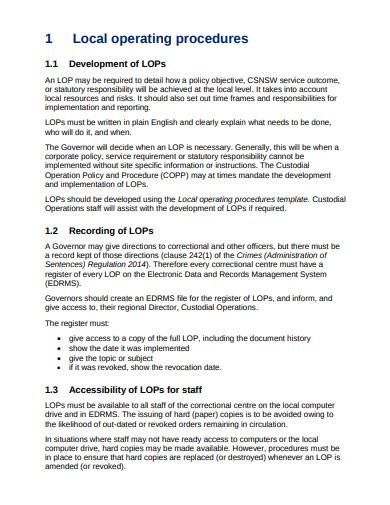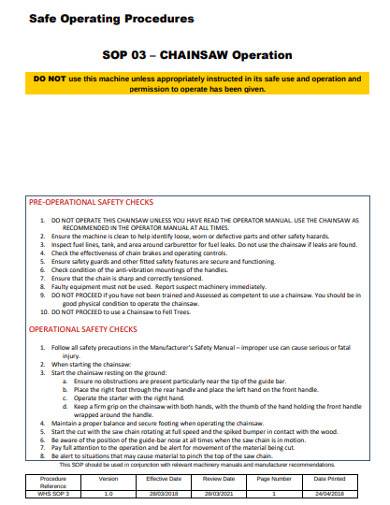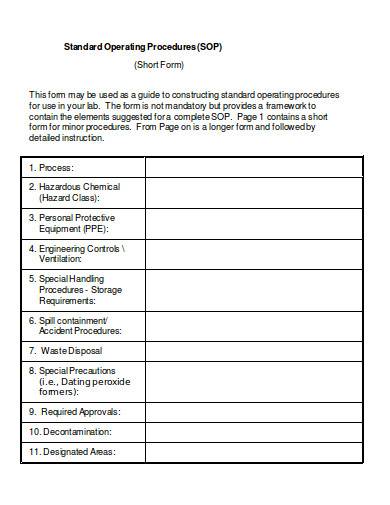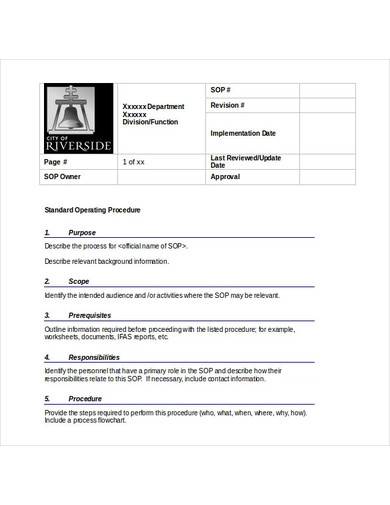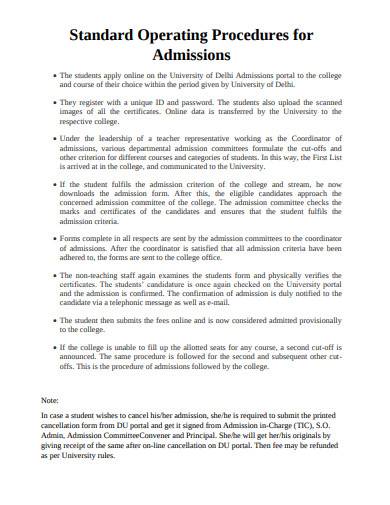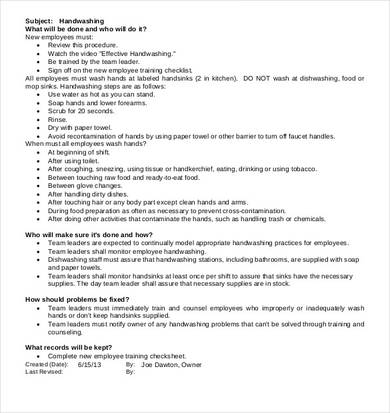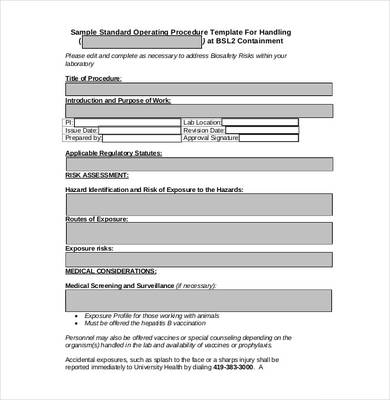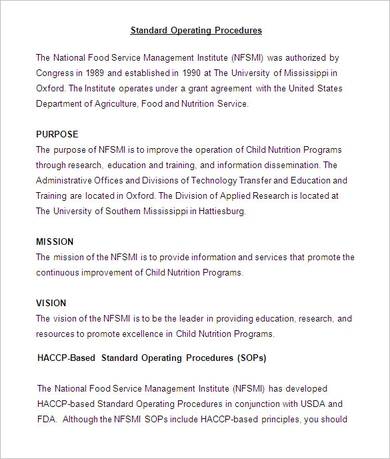How do people learn to do things? If you’re an employee, you learn to do the job through training before you get to do the real job. This is how most companies deal with new employees, regardless if they have experience or not. It’s an excellent way to properly induct and introduce an employee to the company and their new job. This orderly transition of new employees is all thanks to an operating procedure. Every organization follows a specific set of operating procedures. How does this operating procedure work, and why is it important? Let’s find out.
FREE 10+ Operating Procedures Samples & Templates in MS Word | PDF
1. Local Operating Procedures Template
2. Sample Safe Operating Procedures
3. Operating Procedures Short Form
4. SOP Word Template
5. Pest Control Operating Procedure Template
6. Operating Procedures for Admissions
7. Sanitation Standard Operating Procedures
8. Interim Operating Procedures Sample
9. Food Operating Procedures Template
10. Standard Operating Procedure Template
11. Sample Standard Operating Procedure
What Is an Operating Procedure?
An operating procedure is a set of steps that intends to tell individuals or workers what to do in specific situations. The procedure can be for simple processes or for complex routine operations. Operating procedures serve as important communication tools in a company to ensure that all personnel clearly understand exactly what the company wants them to do. Operating procedures are standardized to establish uniformity in the processes performed throughout a company.
In the US and in the UK, every military unit follows a unique set of procedures called a standard operating procedure or SOP. Setting standard operating procedures ensures work efficiency and yields high-quality output. As mentioned, it helps establish uniformity in personnel performance, which results to compliance with industry regulations. It is also the best way to reduce miscommunication across a company or military unit. Standard operating procedures are useful tools in different fields of work, not just in the military. There are standard operating procedures for different businesses, for clinical research and practice, for regularizing employees, for visa applications, etc.
How to Make an Operating Procedure
Every institution is responsible for making specific standard operating procedures that are relevant and applicable to the nature of their work. While there is no shortcut available in making a standard operating procedure, there are essential tips that you can take advantage of that will make the process easier.
1. Use a Simple SOP Format
Complicated doesn’t always mean the best. when choosing a format for a standard operating procedure, it is best to choose a simple format that both writer and audience can understand. A lot of things can be done using a simple format and the writer can focus more on the content rather than spending too much time on how it should look like.
2. Create a Checklist
The steps required in an operating procedure will vary depending on what the procedure is for. First, come up with a simple checklist or to do list of the different tasks involved in the process. Simple checklists are best suited for small teams that do not really require detailed instructions. Then there is a complex liner checklist, which is just a detailed version of a simple checklist. Here, you can record every detail of the process as you go along the procedure.
3. Create a Process Flow Diagram
Diagrams provide a visual representation of the process. Instead of just steps in words, it is easier to determine the flow of the process by drawing a flow chart or a diagram. Some institutions create diagrams first and then put them into writing. Other institutions have both to ensure that their employees clearly understand the process.
4. Determine Your Purpose
Why are you making a standard operating procedure? By answering this question, you can write a step-by-step instructions on actions taken or how decisions are made. An effective operating procedure starts with a purpose that is incorporated throughout the entire operating procedures.
5. Be Concise and Consistent
Use a consistent writing style that suits your audience. Base your writing style on factors like professional setting, company size, international involvement and the company’s years in business. Whatever writing style you choose, remember to always stay consistent and concise with what you write.
FAQ’s
What are the parts of an operating procedure?
An operating procedure generally has five parts. They are the title page, table of contents, quality assurance or quality control section, and the references section. The title page includes the name of the company or organization, what the steps are for, the department to which the steps are intended, revision number, and release dates. Operating procedures are often lengthy os a table of contents is necessary so that desired sections can be easily located. The quality assurance or quality control section provides the guidelines for the procedure, and the references section consists of a list of sources where information for the procedure are gathered.
What are the advantages of standard operating procedures?
Aside from serving as a great communication tool across a company, standard operating procedures have a lot more to offer. It helps a business save time and money by minimizing mistakes in the production of products and performance of services. The output of every employee is guaranteed to be consistent because they follow the correct process. And if employees make mistakes simply because they failed to follow SOP, you can hold them accountable for it. With a standard operating procedure, employers can create a safe working environment for their employees.
No one operating procedure is perfect for all types of processes. That is why it is essential to carefully plan the instructions or steps to include in the procedure. The operating procedure samples and templates provided above will help you plan and build an operating procedure that applies to your institution. Check them out now!
Related Posts
FREE 8+ Sample Procedural Manual Templates in PDF
FREE 8+ Sample Operations Manual Templates in PDF MS Word
FREE 12+ Audit Checklist Samples & Templates in Excel MS Word ...
FREE 9+ Maintenance Engineer Job Description Samples in MS ...
FREE 10+ Sample Vacation Request Forms in MS Word PDF
FREE 11+ Laboratory Audit Report Samples & Templates in PDF ...
FREE 8+ Anesthesiologist Job Descriptions in PDF
FREE 10+ Child Care Risk Management Plan Samples in PDF MS ...
FREE 13+ Policy and Procedure Templates in PDF
IT Manual Template
FREE A Checklist: When Should You Fire an Employee [ With ...
FREE 13+ Operating Statement Samples in PDF MS Word | Excel
FREE 8+ Retail Employee Handbook Samples in PDF DOC
FREE 6+ Sample Business Manual Templates in PDF
FREE 5+ Sample Instruction Manual Templates in MS Word PDF
